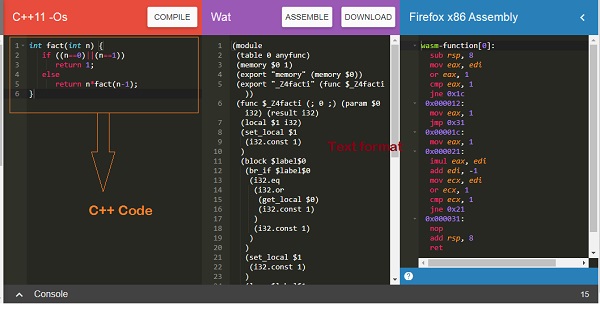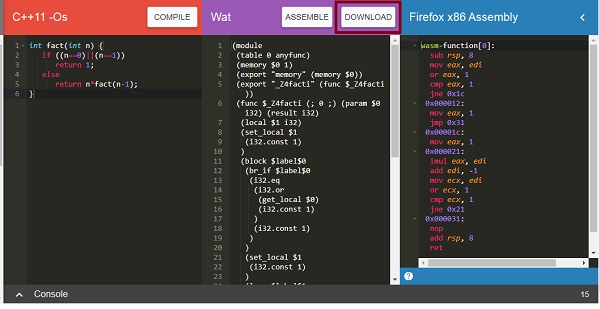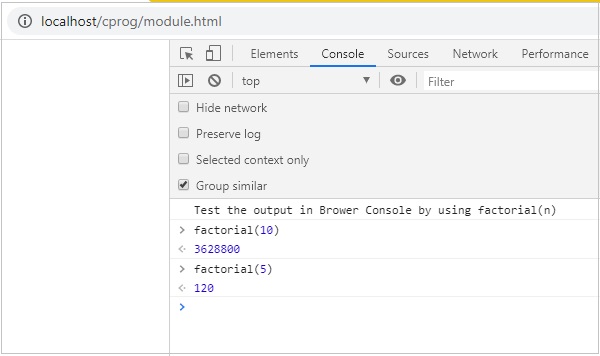
- WebAssembly Tutorial
- WebAssembly - Home
- WebAssembly - Overview
- WebAssembly - Introduction
- WebAssembly - WASM
- WebAssembly - Installation
- WebAssembly - Tools to Compile to WASM
- WebAssembly - Program Structure
- WebAssembly - Javascript
- WebAssembly - Javascript API
- WebAssembly - Debugging WASM in Firefox
- WebAssembly - “Hello World”
- WebAssembly - Modules
- WebAssembly - Validation
- WebAssembly - Text Format
- WebAssembly - Convert WAT to WASM
- WebAssembly - Dynamic Linking
- WebAssembly - Security
- WebAssembly - Working with C
- WebAssembly - Working with C++
- WebAssembly - Working with Rust
- WebAssembly - Working with Go
- WebAssembly - Working with Nodejs
- WebAssembly - Examples
- WebAssembly Useful Resources
- WebAssembly - Quick Guide
- WebAssembly - Useful Resources
- WebAssembly - Discussion
WebAssembly - Modules
We have seen how to get a .wasm file from c /c++ code. In this chapter, we will convert the wasm into a WebAssembly module and execute the same in the browser.
Let us use the C++ Factorial code as shown below −
int fact(int n) {
if ((n==0)||(n==1))
return 1;
else
return n*fact(n-1);
}
Open Wasm Explorer which is available at https://mbebenita.github.io/WasmExplorer/ as shown below −

The first column has the C++ factorial function, the 2nd column has the WebAssembly text format and the last column has x86 Assembly code.
The WebAssembly Text format −
(module
(table 0 anyfunc)
(memory $0 1)
(export "memory" (memory $0))
(export "_Z4facti" (func $_Z4facti))
(func $_Z4facti (; 0 ;) (param $0 i32) (result i32)
(local $1 i32)
(set_local $1
(i32.const 1)
)
(block $label$0
(br_if $label$0
(i32.eq
(i32.or
(get_local $0)
(i32.const 1)
)
(i32.const 1)
)
)
(set_local $1
(i32.const 1)
)
(loop $label$1
(set_local $1
(i32.mul
(get_local $0)
(get_local $1)
)
)
(br_if $label$1
(i32.ne
(i32.or
(tee_local $0
(i32.add
(get_local $0)
(i32.const -1)
)
)
(i32.const 1)
)
(i32.const 1)
)
)
)
)
(get_local $1)
)
)
The C++ function fact has been exported as “_Z4facti” in WebAssembly Text format.
Click on the download button to download the wasm code and save the file as factorial.wasm.

Now to convert the .wasm code to the module we have to do the following −
Step 1
Convert the .wasm into arraybuffer by using ArrayBuffer. The ArrayBuffer object will return you a fixed-length binary data buffer.
Step 2
The bytes from ArrayBuffer have to be compiled into a module by using WebAssembly.compile(buffer) function.
The WebAssembly.compile() function compiles and returns a WebAssembly.Module from the bytes given.
Here, is the Javascript code that is discussed in Step 1 and 2.
<script type="text/javascript">
let factorial;
fetch("factorial.wasm")
.then(bytes => bytes.arrayBuffer())
.then(mod => WebAssembly.compile(mod))
.then(module => {return new WebAssembly.Instance(module) })
.then(instance => {
factorial = instance.exports._Z4facti;
console.log('Test the output in Brower Console by using factorial(n)');
});
</script>
Code Explanation
Javascript browser API fetch is used to get the contents of factorial.wasm.
The content is converted to bytes using arrayBuffer().
The module is created from bytes by calling WebAssembly.compile(mod).
The instance of a module is created using new
WebAssembly.Instance(module)
The factorial function export _Z4facti is assigned to variable factorial by using WebAssembly.Module.exports().
Example
Here, is the module.html along with the javascript code −
module.html
<!doctype html>
<html>
<head>
<meta charset="utf-8">
<title>WebAssembly Module</title>
</head>
<body>
<script>
let factorial;
fetch("factorial.wasm")
.then(bytes => bytes.arrayBuffer())
.then(mod => WebAssembly.compile(mod))
.then(module => {return new WebAssembly.Instance(module) })
.then(instance => {
factorial = instance.exports._Z4facti;
console.log('Test the output in Browser Console by using factorial(n)');
});
</script>
</body>
</html>
Output
Execute module.html in the browser to see the output −
